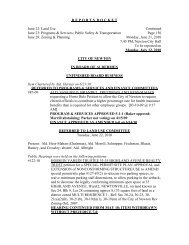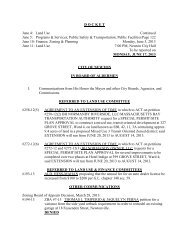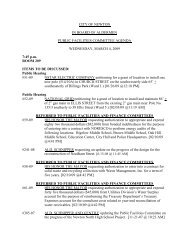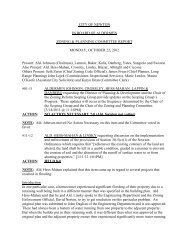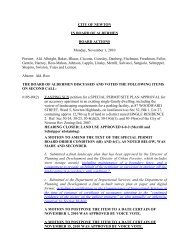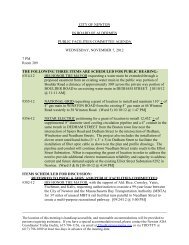Report - Newton, MA
Report - Newton, MA
Report - Newton, MA
You also want an ePaper? Increase the reach of your titles
YUMPU automatically turns print PDFs into web optimized ePapers that Google loves.
Notes on Uses<br />
The single biggest cost is the acquisition cost. The acquisition cost was documented by a copy<br />
of a Purchase and Sale Agreement that was signed on November 5, 2010. The price is $780,000.<br />
The City of <strong>Newton</strong> commissioned an as-is appraisal that was performed by Shepherd<br />
Associates; the as-is value as of December 17, 2010 is $780,000.<br />
The project summary contained a description of the work and an estimate of the costs. The<br />
description and estimate were prepared by the project’s architect.<br />
The soft costs are consistent with what I saw during my nine-year career at DHCD reviewing<br />
HOME, HSF and tax credit developments.<br />
The developer fee and overhead is projected at $123,696 or 10% of all other project costs. It is a<br />
reasonable fee for a project of this size, complexity and risk. Moreover, to the extent that the fee<br />
is at risk, it provides the bank and the City of <strong>Newton</strong> a bit of a cushion against cost overruns.<br />
Income and Expenses<br />
All income is noted on the submitted operating proforma; note that there are no pay laundry<br />
facilities, no commercial units and parking is free. The projected rents are within the HOME<br />
limits assuming that the utility allowance for tenant-paid gas heat, gas cooking and unit<br />
electricity does not exceed $145/month.<br />
The projections for income and expense inflation are higher than the experience of the recent<br />
past. Rather than a 3% increase in income, the developer should consider running the numbers at<br />
2% and rather than 4% for the expenses, 2.5% is more in line with recent expense inflation.<br />
However, revision of these underwriting assumptions does not change the overall projection that<br />
this is a financially feasible project. The vacancy rate assumption is reasonable: 5%.<br />
The management fee is 7% of gross income, which is reasonable for a small building. If the<br />
projections are based on the current owner’s actual bills, it would be helpful to have copies of<br />
recent insurance, utility and tax bills in the file. The replacement reserve at $500/unit is<br />
appropriately higher than on larger projects ($300-350/unit) since this is a moderate<br />
rehabilitation of an occupied building. With regard to real estate taxes, to the extent that the<br />
building’s assessment is a function of its income, the reconfiguration to 3 units and the<br />
imposition of HOME limits will likely result in less future income; hence a lower value for the<br />
building. The developer may be able to file for a reduction in assessment which in turn will<br />
result in lower real estate bills.<br />
The proforma shows that the bank loan has an interest rate of 4% for the first 6 years and a rate<br />
of 5% thereafter. These terms are attractive, and the commitment letter confirms that the first<br />
adjustment is capped at 5%.




